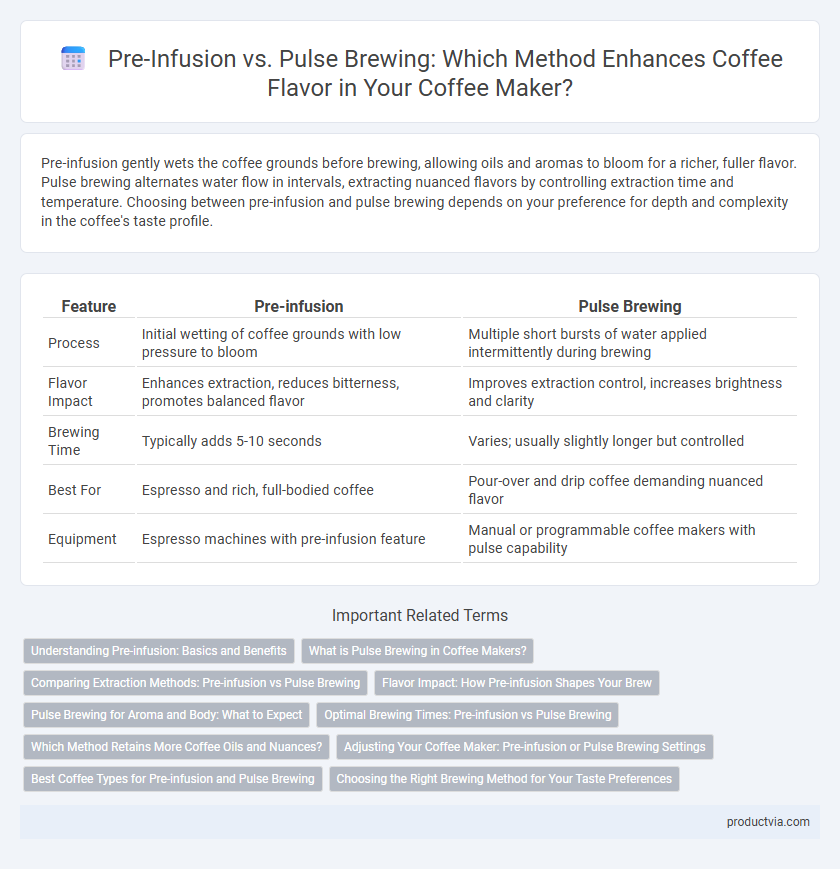Pre-infusion gently wets the coffee grounds before brewing, allowing oils and aromas to bloom for a richer, fuller flavor. Pulse brewing alternates water flow in intervals, extracting nuanced flavors by controlling extraction time and temperature. Choosing between pre-infusion and pulse brewing depends on your preference for depth and complexity in the coffee's taste profile.
Table of Comparison
| Feature | Pre-infusion | Pulse Brewing |
|---|---|---|
| Process | Initial wetting of coffee grounds with low pressure to bloom | Multiple short bursts of water applied intermittently during brewing |
| Flavor Impact | Enhances extraction, reduces bitterness, promotes balanced flavor | Improves extraction control, increases brightness and clarity |
| Brewing Time | Typically adds 5-10 seconds | Varies; usually slightly longer but controlled |
| Best For | Espresso and rich, full-bodied coffee | Pour-over and drip coffee demanding nuanced flavor |
| Equipment | Espresso machines with pre-infusion feature | Manual or programmable coffee makers with pulse capability |
Understanding Pre-infusion: Basics and Benefits
Pre-infusion in coffee making involves gently moistening coffee grounds before full brewing to allow even extraction, reducing bitterness and highlighting nuanced flavors. This process enhances aroma and body by preventing channeling, where water bypasses certain grounds, leading to a more balanced and complex cup. Compared to pulse brewing, which applies intermittent bursts of water, pre-infusion focuses on saturation and extraction control for improved taste consistency.
What is Pulse Brewing in Coffee Makers?
Pulse brewing in coffee makers involves delivering water in short, controlled bursts rather than a continuous stream, allowing coffee grounds to evenly absorb water and release more nuanced flavors. This technique enhances extraction by preventing over-saturation and promoting a balanced taste profile, often resulting in a richer and more complex cup. Pulse brewing contrasts with pre-infusion by actively stirring extraction through intermittent water pulses, optimizing flavor clarity and depth.
Comparing Extraction Methods: Pre-infusion vs Pulse Brewing
Pre-infusion gently soaks coffee grounds with a small amount of water before full extraction, promoting even saturation and minimizing channeling for a balanced flavor. Pulse brewing alternates water flow in intervals, enhancing extraction control and accentuating complex flavor notes by preventing over-extraction. Both methods optimize extraction, but pre-infusion favors smoothness while pulse brewing emphasizes dynamic, vibrant taste profiles.
Flavor Impact: How Pre-infusion Shapes Your Brew
Pre-infusion enhances coffee flavor by gently wetting the grounds before full extraction, allowing even saturation and more balanced extraction of oils and acids. This process reduces bitterness and highlights subtle flavor notes, creating a smoother, more nuanced cup. Pulse brewing, in contrast, introduces water in intervals, which can vary extraction consistency and intensify certain flavor components but may lead to uneven taste profiles.
Pulse Brewing for Aroma and Body: What to Expect
Pulse brewing enhances coffee aroma and body by delivering intermittent bursts of water, allowing fuller extraction of oils and flavors. The technique intensifies the coffee's fragrance and produces a richer mouthfeel compared to continuous pre-infusion. Expect a well-balanced cup with pronounced aromatic complexity and robust body using pulse brewing.
Optimal Brewing Times: Pre-infusion vs Pulse Brewing
Pre-infusion gently wets coffee grounds for 20-30 seconds, allowing even saturation to enhance flavor extraction and reduce bitterness. Pulse brewing alternates between short bursts of water and pauses, extending the total brew time to optimize extraction and develop a complex aroma. Optimal brewing times vary, with pre-infusion typically shorter, while pulse brewing requires longer intervals to balance strength and clarity in the cup.
Which Method Retains More Coffee Oils and Nuances?
Pre-infusion gently wets coffee grounds, allowing oils and flavor compounds to bloom and extract evenly, which enhances the coffee's aroma and subtle nuances. Pulse brewing intermittently releases water in controlled bursts, promoting a balanced extraction but can sometimes cause uneven oil retention. Pre-infusion typically retains more coffee oils and delicate flavors, resulting in a richer and more nuanced cup.
Adjusting Your Coffee Maker: Pre-infusion or Pulse Brewing Settings
Adjusting your coffee maker to use pre-infusion saturates coffee grounds evenly, enhancing flavor extraction and reducing bitterness for a balanced cup. Pulse brewing controls water flow in intervals, allowing grounds to bloom and release aromatic oils, resulting in richer taste complexity. Selecting between pre-infusion and pulse brewing depends on the coffee variety and desired flavor profile for optimal brewing performance.
Best Coffee Types for Pre-infusion and Pulse Brewing
Pre-infusion enhances extraction for medium to dark roasts, especially in single-origin Arabica beans, by evenly wetting the grounds and releasing nuanced flavors. Pulse brewing excels with lighter roasts and blends, where intermittent water application highlights acidity and complex aromatic notes. Both methods optimize flavor profiles by adjusting water flow to suit specific coffee characteristics.
Choosing the Right Brewing Method for Your Taste Preferences
Pre-infusion gently wets the coffee grounds to allow even extraction, resulting in a smoother, more balanced flavor ideal for highlighting subtle coffee notes. Pulse brewing alternates water flow to create varied extraction intensities, enhancing the complexity and brightness of the coffee's taste profile. Selecting between pre-infusion and pulse brewing depends on whether you prefer a mellow, consistent cup or a vibrant, dynamic flavor experience.
Pre-infusion vs Pulse brewing for flavor Infographic

 productvia.com
productvia.com